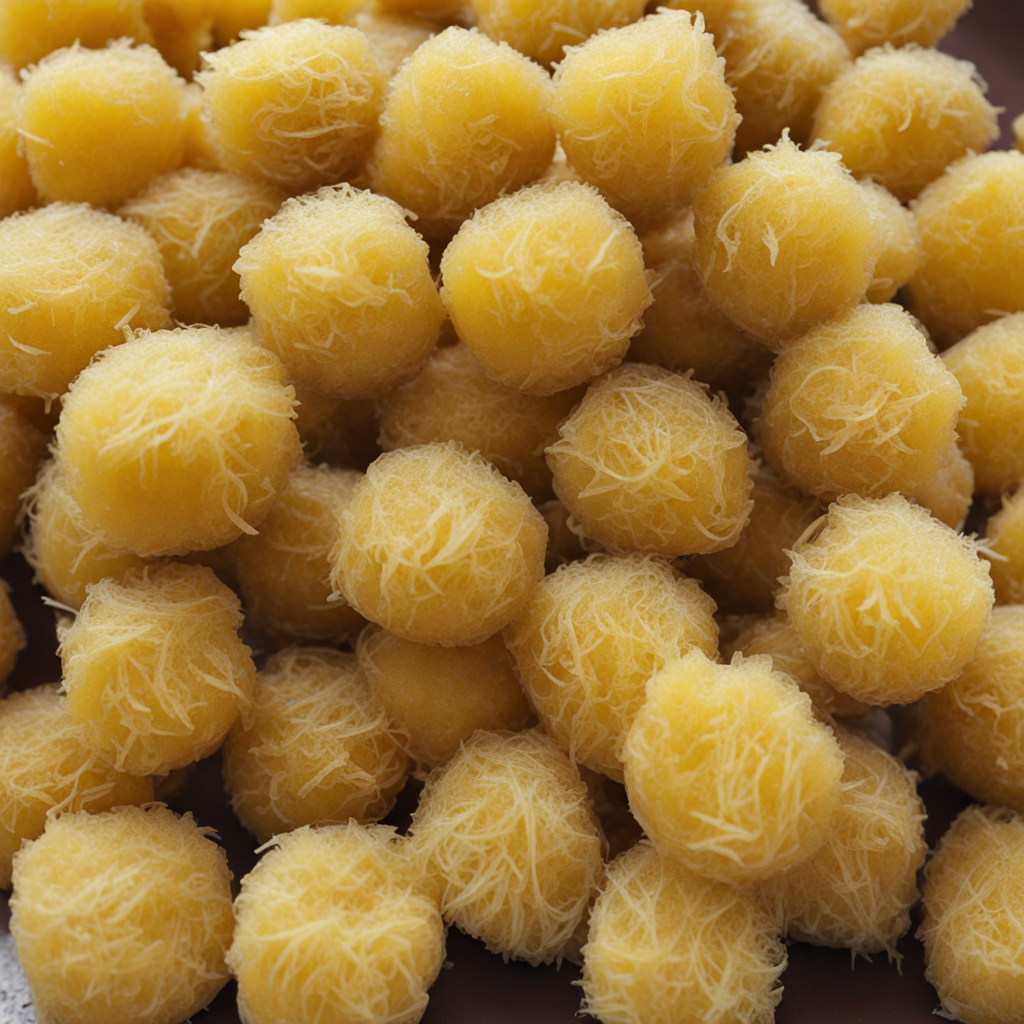Cocada amarela
Cocada amarela is a delightful treat from Cape Verde, characterized by its rich, yellow hue that beckons with promises of sweetness and flavor. This traditional dessert is primarily made from grated coconut, sugar, and eggs, which blend together to create a luscious texture. The combination of these ingredients results in a chewy, almost caramel-like consistency that melts in your mouth. Each bite is a celebration of tropical coconut flavor, perfectly balanced with just the right amount of sweetness, making it an irresistible indulgence for those with a sweet tooth. The process of making cocada amarela is a labor of love, often passed down through generations. The grated coconut is mixed with sugar, and the addition of egg gives it a custard-like richness that enhances its flavor profile. Once combined, the mixture is shaped into small mounds or bars and baked until they achieve a golden crust. This baking process caramelizes the sugar slightly, adding depth and complexity to the taste while maintaining the moistness of the coconut inside. Cocada amarela is not just a dessert; it's a cultural experience that embodies the spirit of Cape Verde. Often enjoyed during festive occasions or family gatherings, it brings people together with its comforting flavors. Whether served alongside a cup of strong coffee or as a standalone treat, cocada amarela offers a taste of the islands that is both nostalgic and uniquely satisfying, inviting anyone who tries it to savor the essence of Cape Verdean culinary heritage.
How It Became This Dish
Cocada Amarela: A Sweet Journey Through Cape Verde’s Culinary Heritage Cocada amarela, a beloved traditional treat from Cape Verde, is more than just a sweet delicacy; it is a reflection of the archipelago's rich history and cultural identity. This coconut-based confection, characterized by its vibrant yellow color, embodies the fusion of African, Portuguese, and indigenous influences that have shaped Cape Verdean cuisine. To appreciate cocada amarela fully, one must delve into its origins, cultural significance, and how it has evolved over time. Origins Cocada amarela has its roots in the culinary practices of the African diaspora, particularly from the islands of Cape Verde, which were uninhabited until the Portuguese discovered them in the 15th century. The archipelago, located off the coast of West Africa, became a melting pot of cultures due to its strategic position along trade routes and its role as a waypoint for ships bound for the Americas. The primary ingredients of cocada amarela—coconut, sugar, and egg yolks—reflect the agricultural bounty of the islands and the influence of Portuguese colonial cuisine. Coconuts were introduced to Cape Verde by the Portuguese, who brought them from their colonies in Brazil and the Caribbean. The islands' tropical climate proved ideal for cultivating this versatile fruit. The use of sugar, another significant ingredient, is also rooted in the colonial period, when sugarcane plantations flourished in the region, shaping the local economy and diet. Cultural Significance Cocada amarela holds a special place in the hearts of Cape Verdeans, both at home and in the diaspora. It is often served during festive occasions, family gatherings, and religious celebrations, making it a symbol of joy and community. The bright yellow hue is particularly associated with celebration, representing warmth, happiness, and the vibrancy of Cape Verdean culture. In Cape Verdean households, cocada amarela is more than just a dessert; it is a labor of love. Traditionally, families would gather to prepare the sweet, with each member contributing to the process. The making of cocada amarela has become a communal activity, reinforcing bonds between generations and fostering a sense of belonging. Sharing this treat is an expression of hospitality, and it is not uncommon for Cape Verdeans to offer cocada amarela to guests as a gesture of goodwill. In the broader context of Cape Verdean culture, cocada amarela also resonates with themes of resilience and adaptation. As an island nation with a history of emigration and economic challenges, the preparation of cocada amarela can be seen as a celebration of resourcefulness. Utilizing local ingredients, families have created a dish that is not only delicious but also reflective of their heritage. Development Over Time The evolution of cocada amarela mirrors the broader changes in Cape Verdean society. Initially, this sweet treat was made solely from coconut and sugar, adhering closely to traditional recipes passed down through generations. However, as Cape Verdeans migrated to various parts of the world, particularly to the United States and Europe, the recipe began to adapt and incorporate new influences. In diaspora communities, cocada amarela has seen variations that reflect the availability of ingredients and the tastes of different cultures. For instance, some versions now incorporate additional spices like cinnamon or nutmeg, which are more commonly found in Caribbean and Latin American desserts. Others might experiment with textures by adding nuts or other types of dried fruits. These adaptations highlight the versatility of cocada amarela and its ability to resonate with diverse audiences. Moreover, the globalization of culinary practices has led to a renewed interest in traditional Cape Verdean foods. As Cape Verdeans have sought to preserve their heritage in foreign lands, cocada amarela has emerged as a proud emblem of cultural identity. Food festivals, cookbooks, and culinary workshops have further popularized this treat, allowing new generations to connect with their roots. Contemporary Relevance Today, cocada amarela is not just a nostalgic reminder of home for Cape Verdeans abroad; it is gaining recognition as part of the broader narrative of African and Afro-Latin cuisine. The increasing interest in global food culture has sparked renewed appreciation for traditional dishes like cocada amarela, leading to its inclusion in culinary showcases and food markets. In Cape Verde, cocada amarela remains a staple at local bakeries and street vendors, attracting both locals and tourists. Its appeal lies not only in its sweet, rich flavor but also in its story—each bite carries the essence of Cape Verde's history, culture, and resilience. As tourism continues to grow on the islands, the demand for authentic culinary experiences has prompted many chefs to reimagine cocada amarela, often presenting it alongside contemporary dishes that highlight local ingredients and flavors. Conclusion Cocada amarela is more than just a dessert; it is a vibrant reflection of Cape Verde’s history, culture, and adaptability. From its origins rooted in colonial influences to its evolution in the diaspora, this sweet treat embodies the resilience and creativity of a people who have navigated the complexities of their identity. As Cape Verdeans continue to celebrate their heritage through food, cocada amarela stands as a testament to the power of culinary traditions to unite, inspire, and foster a sense of belonging. Whether enjoyed during a family gathering or at a festive celebration, cocada amarela remains a cherished symbol of the warmth and richness of Cape Verdean culture, inviting all who taste it to partake in its sweet history.
You may like
Discover local flavors from Cape Verde







